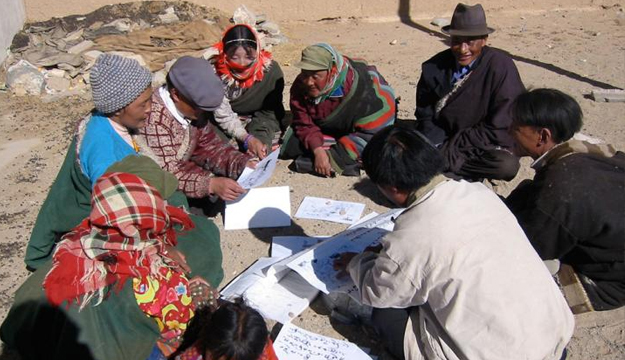Pendeba in Tibet

Pendebas, meaning “workers who benefit the village” in Tibetan, are locally elected villagers who are trained in the practical skills of environmental protection, primary healthcare, and income generation. This knowledge is then transfered to villages through formal and informal teaching and word of mouth exchanges. Each Pendeba increases local capacity by helping entire villages identify sustainable solutions to environmental, health, and economic challenges. Through the Pendeba Program, and in cooperation with the regional government and other organizations, Future Generations has achieved major conservation successes in the Tibet Autonomous Region. The Pendeba Program was developed in 1994 in response to the growing need for local preserve wardens in the Qomolangma National Nature Preserve (QNNP) in the Mt. Everest region.
The program was part of a new approach to protected areas management that saw local inhabitants of the newly created protected zone trained in conservation leadership. According to local need, the Pendeba’s curriculum has expanded from environmental awareness to addressing other practical needs. Since 1994, the Program has been extended to Lyingchi Prefecture in 2002, to the Naggu Prefecture in 2003, and to the Four Great Rivers region of Chamdo and Linzhi Prefectures in 2006. To date, there are more than 1,000 Pendebas working throughout all of the program areas.Through the efforts of Pendebas, life is improving in the villages of Eastern Tibet. Measurable progress has been observed in fuel conservation, use of solar cooking equipment, as well as the use of irrigation systems. Significant progress has been made in increasing basic health care awareness and family planning. Many communities have

started to implement income generation programs in order to reduce dependency on local natural resources. These programs include green house management, kitchen gardening, livestock, production and sale of handcrafts, and the sale of local specialties such as medicinal herbs.
In villages across Tibet, where the environment is harsh and access to modern amenities is rare, communities face countless challenges. Lack of basic healthcare is one of the most serious problems and diseases such as pneumonia and tuberculosis present a great risk to these communities. Limitations in transportation infrastructure and communications leave remote villages vulnerable and lacking resources. Common methods of income generation are also not feasible in the high altitude environment of Tibet and as a result, communities often depend on local natural resources to support themselves. Unfortunately, without proper education in conservation and sustainable development, the methods used to extract these resources combined with intensive harvesting can lead to severely damaged ecosystems.
The Pendeba Program was created to address these challenges and to establish a framework for bottom-up conservation and development that is implemented by and for local communities. By training locally elected villagers in the basics of healthcare and education, natural resource management, and income generation, the Pendeba Program enables communities to address their own needs while protecting the local environment. The Program is based on the three thematic components of education, livelihoods, and environment.
Education
- provide educational materials for children
- teach fundamentals of basic health care
- build awareness of local natural resources and their importance
- improve technical skill
Livelihoods
- ecotourism
- handicrafts
- agricultural products with appropriate technology and improved breeding techniques and seeds
- appropriate use of natural resources (mushrooms, herbal medicines, etc.)
Environment
- sustainable use of local resources
- the use of renewable energy such as solar, wind, and biogas
- the protection of endangered species
- better sanitation methods to protect local water supplies
The Gama Valley Forest is an important ecological site in the Qomolangma National Nature Preserve. Before coming under official protection, the forest was subject to timber extraction by villagers. Seeing the destructive, long term impacts of this practice, a local Pendeba undertook an ambitious reforestation initiative. He followed the example set by a Pendeba from Chudang and established a large nursery of poplar, willow, and apple trees. The nursery created an alternative source of employment for the villagers, and many former tree-cutters have become tree-planters.
In Basong village, which is under the care of Pendeba Zhenchiong, there is an ongoing problem with chronic diarrhea. As the local Pendeba, she teaches the villagers about oral rehydration therapy (ORT). Local resources are sparse, but in Basong village, a matchbox of roasted barley flour, half a beer cap of salt, and a beer bottle of boiled water are all that is needed to make an adequate ORT solution. Pendeba Zhenchiong has also helped her village create a community forest by planting poplar seedlings. Initially, villagers were skeptical and thought that Basong was too high in elevation to grow trees, but the thriving new trees prove otherwise.
In Sanddanlin Village, like many of Tibet’s villages, agriculture is impossible due to high altitudes. With little more than basic livestock, typical families in the area were very poor and lacked money to pay for the most basic medicines. To address this issue, a local Pendeba set up an insurance fund in the form of a livestock cooperative. He obtained 32 goats from villagers and the community collectively looked after them. Each spring and fall, after the sale of the wool from the goats, he put the proceeds into the cooperative to buy medicine. Today the number of goats has grown to 63 and the cooperative has 1,098 RMB (about $137) in reserves and has reinvested 200 RMB (about $200) into medicine. In total, the cooperative is now worth 6,338 RMB (about $782).
